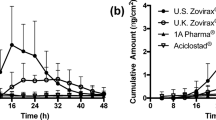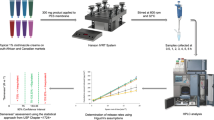Abstract
Acyclovir, indicated in the treatment of herpes labialis (“cold sores”), is formulated as semisolid topical dosage forms and marketed in numerous countries. Since the formulations of the various acyclovir products may differ from country to country, this study was undertaken to compare the in vitro release of acyclovir from various generic cream products available on the South African and Indian markets using the respective brand/innovator product as the reference product. The in vitro studies were carried out using vertical diffusion cells with a diffusional surface area of 1.767 cm2 and various commercially available membranes. Normal saline was used as receptor fluid and the temperature maintained at 32 ± 0.5°C. The in vitro release comparisons were based on the recommendations described in the US Food and Drug Administration Draft Guidance for acyclovir ointment and the SUPAC-SS Guidance for non-sterile semisolid dosage forms. The release rates (slope) of the test (T) and the relevant reference product (R) were monitored and compared. The comparative release of acyclovir from the various generic formulations compared with the reference product was found to be within the limits of 75–133.33% with a 90% confidence interval. These experiments indicate that the generic acyclovir cream formulations exhibited release rates that were comparable to the innovator product and could be considered to be bioequivalent.

Similar content being viewed by others
References
FDA, CDER. Guidance for Industry. Topical dermatologic corticosteroids: in vivo bioequivalence. http://www.fda.gov/downloads/Drugs/GuidanceComplianceRegulatoryInformation/Guidances/ucm070234.pdf(1995). Accessed 9 Jan 2013.
Lionberger RA. FDA critical path initiatives: opportunities for generic drug development. AAPS J. 2008;10(1):103–9.
Chang RK, Raw A, Lionberger R, Yu L. Generic development of topical dermatologic products: formulation development, process development, and testing of topical dermatologic products. AAPS J. 2013;15(1):41–52.
Draft Guidance on Acyclovir. 2012. http://www.fda.gov/downloads/Drugs/GuidanceComplianceRegulatoryInformation/Guidances/ucm296733.pdf. Accessed 22 Jan 2013.
Raney S, Lehman P, Franz T. 30th Anniversary of the Franz cell finite dose model: the crystal ball of topical drug development. Drug Deliv Technol. 2008;7(8):32–7.
Trottet L, Owen H, Holme P, Heylings J, Collin IP, Breen A, et al. Are all acyclovir cream formulations bioequivalent? Int J Pharm. 2005;304(1–2):63–71.
Prausnitz MR, Langer R. Transdermal drug delivery. Nat Biotechnol. 2008;26(11):1261–8.
Wester R, Maibach H. Review: percutaneous absorption of drugs. Clin Pharmacokinet. 1992;23:253–66.
Michaels A, Chandrasekaran SK, Francis W, Meredith M. Drug permeation through human skin: theory and in vitro experimental measurement. A I Ch E J. 1975;21:985–96.
Henning A, Schaefer UF, Neumann D. Potential pitfalls in skin permeation experiments: influence of experimental factors and subsequent data evaluation. Eur J Pharm Biopharm. 2009;72:324–31.
Liebenberg W, Engelbrecht E, Wessels A, Devarakonda B, Yang W, De Villiers MM. A comparative study of the release of active ingredients from semisolid cosmeceuticals measured with Franz, enhancer or flow-through cell diffusion apparatus. J Food Drug A. 2004;12(1):19–28.
Kanfer I, Tettey-Amlalo RNO, Au WL, Hughes-Formella B. Assessment of topical dosage forms intended for local or regional activity. In: Kanfer I, Shargel L, editors. Generic Drug Product Development: Specialty Dosage Forms. New York: Marcel Dekker Inc; 2009. p. 54–103.
EMEA, CHMP. CHMP/EWP/21441/2006. Questions and answer on guideline title: Clinical investigation of corticosteroids intended for use on the skin. http://www.ema.europa.eu/docs/en_GB/document_library/Scientific_guideline/2009/09/WC500003330.pdf (2006). Accessed 23 Feb 2013.
Elion GB. The biochemistry and mechanism of action of acyclovir, J Antimicrob Chemother. 1983;12 B: 9-17.
FDA-SUPAC-SS. Guidance for industry. SUPAC-SS non-sterile semisolid dosage forms. Scale-up and postapproval changes: chemistry, manufacturing and controls. In vitro release testing and in vivo bioequivalence documentation. 1997.
Acknowledgments
This study was supported by the Biopharmaceutics Research Institute (BRI), Rhodes University, South Africa and Dr. Prabhakar Kore Basic Sciences Research Center (BSRC), KLE University, Belgaum, India.
Author information
Authors and Affiliations
Corresponding author
Additional information
Guest Editor: Susan D’Souza
Rights and permissions
About this article
Cite this article
Nallagundla, S., Patnala, S. & Kanfer, I. Comparison of In Vitro Release Rates of Acyclovir from Cream Formulations Using Vertical Diffusion Cells. AAPS PharmSciTech 15, 994–999 (2014). https://doi.org/10.1208/s12249-014-0130-y
Received:
Accepted:
Published:
Issue Date:
DOI: https://doi.org/10.1208/s12249-014-0130-y




